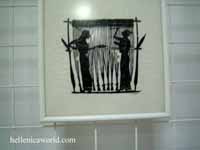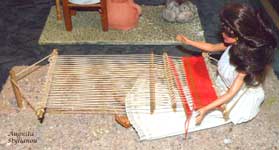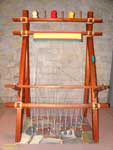.




Horizontal seated loom, Vertical Mycenaean loom,
Istos
(ἱστός), a loom.
Although weaving was among the Greeks and Romans a distinct trade, carried on by a separate class of persons (ὑφάνται, textores, and textrices, linteones), yet every considerable domestic establishment, especially in the country, contained a loom (Cato , R. R. 10, 14) together with the whole apparatus necessary for the working of wool (ταλασία, ταλασιουργία, lanificium). (See Calathus.) These occupations were all supposed to be carried on under the protection of Athené or Minerva, specially denominated Ergané (Ἐργάνη). When the farm or the palace was sufficiently large to admit of it, a portion of it called the histon (ἱστῶν) (Varro, R. R. i. 2) or textrinum was devoted to this purpose. The work was there principally carried on by female slaves (ἔριθοι, quasillariae), under the superintendence of the mistress of the house (Theocr. xv. 80). Everything woven consists of two essential parts, the warp and the woof, called in Latin stamen and subtegmen, subtemen, or trama; in Greek στημών and κροκή. The warp was called stamen in Latin (from stare) on account of its erect posture in the loom. The corresponding Greek term στημών, and likewise ἱστός, have evidently the same derivation. For the same reason, the very first operation in weaving was to set up the loom (ἱστὸν στήσασθαι); and the web or cloth, before it was cut down or “descended” from the loom, was called pendens or pendula tela, because it hung from the transverse beam, or iugum. These particulars are all clearly exhibited in the picture of Circé's loom given in the annexed illustration. We observe there, at about the middle of the apparatus, a transverse rod passing through the warp. A straight cane was well adapted to be so used, and its application is clearly expressed by Ovid in the words stamen secernit harundo. In plain weaving it was inserted between the threads of the warp so as to divide them into two portions, the threads on one side of the rod alternating with those on the other side throughout the whole breadth of the warp. In a very ancient form of the loom there was a roller underneath the iugum, turned by a handle, and on which the web was wound as the work advanced. The threads of the warp, besides being separated by a transverse rod or plank, were divided into thirty or forty parcels, to each of which a stone was suspended for the purpose of keeping the warp in a perpendicular position, and allowing the necessary play to the strokes of the spatha. While the comparatively coarse, strong, and much-twisted thread designed for the warp was thus arranged in parallel lines, the woof remained upon the spindle (fusus), forming a spool, bobbin, or pen (πήνη). This was either conveyed through the warp without any additional contrivance, or it was made to revolve in a shuttle (radius). This was made of box-wood, brought from the shores of the Euxine, and was pointed at its extremities that it might easily force its way through the warp. All that is effected by the shuttle is the conveyance of the woof across the warp. To keep every thread of the woof in its proper place it is necessary that the threads of the warp should be decussated. This was done by the leashes, called in Latin licia, in Greek μίτοι. By a leash we are to understand a thread having at one end a loop, through which a thread of the warp was passed, the other end being fastened to a straight rod called liciatorium, and in Greek κανών. The warp, having been divided by the harundo, as already mentioned, into two sets of threads, all those of the same set were passed through the loops of the corresponding set of leashes, and all these leashes were fastened at their other end to the same wooden rod. At least one set of leashes was necessary to decussate the warp, even in the plainest and simplest weaving. The number of sets was increased according to the complexity of the pattern, which was called bilix or trilix (δίμιτος, τρίμιτος or πολύμιτος) according as the number was two, three, or more. The process of annexing the leashes to the warp was called ordiri telam, also licia telae addere, or adnectere. It occupied two women at the same time, one of whom took in regular succession each separate thread of the warp and handed it over to the other (παραφέρειν, παραδίδοναι, προσφωρεῖσθαι); the other, as she received each thread, passed it through the loop in proper order; an act which is now called “entering,” in Greek διάζεσθαι. Supposing the warp to have been thus adjusted, and the pen or the shuttle to have been carried through it, it was then decussated by drawing forwards the proper rod so as to carry one set of the threads of the warp across the rest, after which the woof was shot back again, and by the continual repetition of this process the warp and woof were interlaced. Two staves were occasionally used to fix the rods in such a position as was most convenient to assist the weaver in drawing her woof across her warp After the woof had been conveyed by the shuttle through the warp, it was driven sometimes downwards, as is represented in the woodcut, but more commonly upwards. Two different instruments were used in this part of the process. The simplest, and probably the most ancient, was in the form of a large wooden sword (spatha, σπάθη). The spatha was, however, in a great degree superseded by the comb (pecten, κεκρίς), the teeth of which were inserted between the threads of the warp, and thus made by a forcible impulse to drive the threads of the woof close together.
The lyre, the favorite musical instrument of the Greeks, was only known to the Romans as a foreign invention. Hence they appear to have described its parts by a comparison with the loom, with which they were familiar. The terms iugum and stamina were transferred by an obvious resemblance from the latter to the former object; and although they adopted into their own language the Greek word plectrum (πλῆκτρον) they used the Latin pecten to denote the same thing, not because the instrument used in striking the lyre was at all like a comb in shape and appearance, but because it was held in the right hand and inserted between the stamina of the lyre, as the comb was between the stamina of the loom.
| Ancient Greece
Science, Technology , Medicine , Warfare, , Biographies , Life , Cities/Places/Maps , Arts , Literature , Philosophy ,Olympics, Mythology , History , Images Medieval Greece / Byzantine Empire Science, Technology, Arts, , Warfare , Literature, Biographies, Icons, History Modern Greece Cities, Islands, Regions, Fauna/Flora ,Biographies , History , Warfare, Science/Technology, Literature, Music , Arts , Film/Actors , Sport , Fashion --- |

